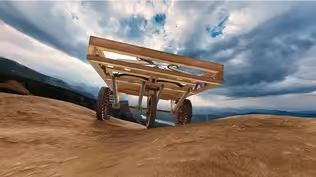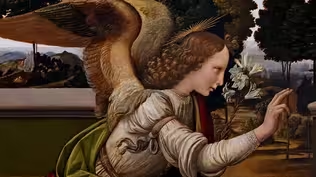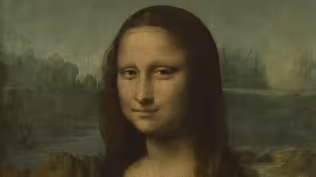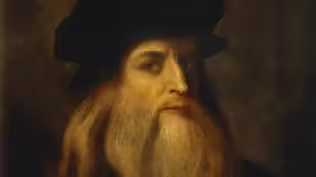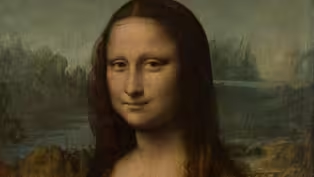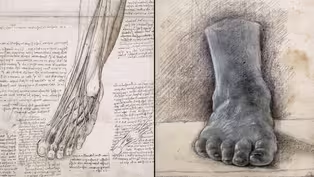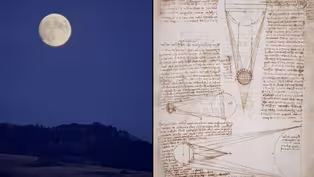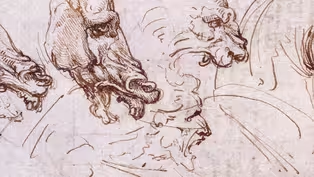
Leonardo da Vinci's The Virgin and Child with Saint Anne
Clip: 11/19/2024 | 7m 45sVideo has Closed Captions
Da Vinci’s The Virgin and Child with Saint Anne showcases his scientific and artistic knowledge.
All of Leonardo da Vinci’s accomplishments are showcased in his unfinished painting The Virgin and Child with Saint Anne. From his scientific and artistic knowledge to observations on how atmospheric phenomena – light, haze, vapor, altitude and distance – affect the appearance of the landscape, the intensity of colors and the sharpness of details.
Problems playing video? | Closed Captioning Feedback
Problems playing video? | Closed Captioning Feedback
Corporate funding for LEONARDO da VINCI was provided by Bank of America. Major funding was provided by the Corporation for Public Broadcasting, and by The Better Angels Society and by...

Leonardo da Vinci's The Virgin and Child with Saint Anne
Clip: 11/19/2024 | 7m 45sVideo has Closed Captions
All of Leonardo da Vinci’s accomplishments are showcased in his unfinished painting The Virgin and Child with Saint Anne. From his scientific and artistic knowledge to observations on how atmospheric phenomena – light, haze, vapor, altitude and distance – affect the appearance of the landscape, the intensity of colors and the sharpness of details.
Problems playing video? | Closed Captioning Feedback
How to Watch Leonardo da Vinci
Leonardo da Vinci is available to stream on pbs.org and the free PBS App, available on iPhone, Apple TV, Android TV, Android smartphones, Amazon Fire TV, Amazon Fire Tablet, Roku, Samsung Smart TV, and Vizio.
Buy Now
Providing Support for PBS.org
Learn Moreabout PBS online sponsorshipGopnik: One of the things that was very important to Renaissance artists, Leonardo included, was the idea of a demonstration, that you would add something to this extraordinary NASA-like project of conquering the world of visual appearances, and one of the things that Leonardo adds very strongly is this idea of aerial perspective, that the atmosphere with which things are seen changes the way that they're seen.
In Leonardo, the beautiful blur enters the world, and he distinguishes between, and he deliberately blurs, makes optical, makes suggestive, invites what's called the beholder's share into the picture, in effect, to complete and deepen, enrich, sweeten the form that we can't entirely see.
That's a Leonardesque contribution.
♪ Man as Leonardo: Above Lake Como toward Germany is the Valley of Chiavenna, where the River Mera flows into this lake.
Here are barren and very high mountains with huge rocks.
They are impossible to climb except on foot.
♪ Narrator: On a trip to the mountains north of Milan, Leonardo observed how atmospheric phenomena-- light, haze, vapor-- as well as altitude and distance affected the appearance of the landscape, the intensity of colors, the sharpness of details.
♪ [Speaking French] Bambach: He is really thinking about what the atmosphere does to color and to light in the distance.
It is the way in which he creates infinity.
Man as Leonardo: I say that the blueness we see in the atmosphere is not intrinsic color but is caused by warm vapor evaporating into minute and imperceptible atoms on which the solar rays fall, rendering them luminous against the infinite darkness of the fiery sphere which lies beyond.
Bambach: He becomes quite obsessed by the idea that you have infinite gradations in tone, in a color.
You also get these indivisible ethereal qualities.
[Bramly speaking French] Narrator: Back in his studio in Milan, Leonardo returned to a theme he had been exploring on and off for years-- the Madonna and Child with Mary's mother Saint Anne.
In the years since his cartoon depicting the 3 figures had caused a stir in Florence, he had made studies of an infant holding a lamb and created another full-scale cartoon that also featured Saint John as an infant.
Now he began work on a painting.
♪ In a preparatory drawing of the Madonna, Leonardo explored her features using the sfumato technique, blending shadows in ways so subtle that her contours practically vanished.
Man as Leonardo: The line itself has neither matter nor substance and may rather be called an imaginary idea than a real object, and this being its nature, it occupies no space.
Farago: He made it his business.
His whole life is, "How can you account "for the way things appear without any drawn lines which are not visible in nature?"
So the sfumato comes in there because sfumato refers to the modeling of figures and how they turn in space and then the most difficult of all of how to make it look like it's surrounded by air.
Leonardo is very insistent there are no lines in nature.
There are edges, so if you're drawing, you draw the edge, but this is not a natural thing.
He says there are no lines in nature.
You simply have a surface which hits another surface, and that's it.
There's no line that runs down that point, and as things get a little way away from the eye, so you don't see these edges precisely, and he said at one point, "The eye does not know the edge of any body."
All bodies exist in space, and all bodies are dimensional... and space is all about relationships between things.
When you're drawing a figure, you have to draw the back side of it and the front side of it.
You have to account for the proximity between things by being able to draw the side that you can't see and then extend the drawing from that part you can't see to the place where the image you can see actually is.
You look at the world as if you have X-ray eyes.
♪ Narrator: The rocky outcrops and distant vertical peaks he'd sketched in fine detail would inform the outdoor space he intended for his subjects.
On a 5 1/2-foot-tall-by- 3 1/2-foot-wide poplar panel, Leonardo probed both the psychological states of Saint Anne, Mary, and Jesus and their natural surroundings.
[Speaking French] ♪ Bambach: We really do see all the sum of all of Leonardo's scientific knowledge, artistic knowledge make their appearance in the painting.
If we look at the foreground especially and see the stratification of the rocks, he's gonna create the continuum of the atmospheric perspective from the foreground to the deep distance.
His objective is to suggest an infinity of space.
♪ Narrator: Leonardo would continue to refine the painting for years, but like so many of his previous works, it, too, would go unfinished.
[Speaking Italian]
Leonardo da Vinci and the Mona Lisa
Video has Closed Captions
Clip: 11/19/2024 | 8m 20s | Leonardo da Vinci spends 14 years working on the Mona Lisa, the culmination of all his knowledge. (8m 20s)
Leonardo da Vinci Investigates the Human Body
Video has Closed Captions
Clip: 11/19/2024 | 7m 22s | Leonardo da Vinci’s study of human anatomy combine scientific exploration with expert artistry. (7m 22s)
Leonardo da Vinci’s Scientific Experiments
Video has Closed Captions
Clip: 11/19/2024 | 9m 53s | Leonardo da Vinci becomes more of a scientist with age and performs experiments to test theories. (9m 53s)
Michelangelo, Leonardo da Vinci and The Battle of Anghiari
Video has Closed Captions
Clip: 11/19/2024 | 10m 9s | Leonardo da Vinci’s The Battle of Anghiari commission pits him against his rival, Michelangelo. (10m 9s)
Providing Support for PBS.org
Learn Moreabout PBS online sponsorshipSupport for PBS provided by:
Corporate funding for LEONARDO da VINCI was provided by Bank of America. Major funding was provided by the Corporation for Public Broadcasting, and by The Better Angels Society and by...

